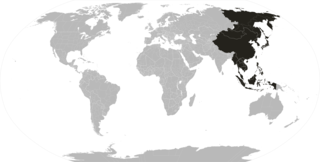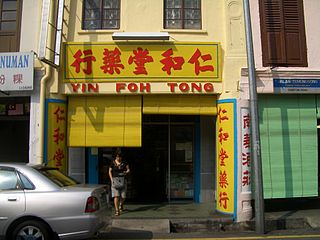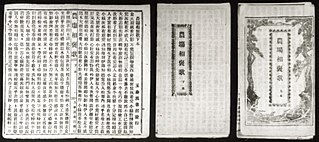See also
| This disambiguation page lists articles associated with the title Chinese braille. If an internal link led you here, you may wish to change the link to point directly to the intended article. |
Chinese braille refers to Standard Mandarin braille systems:
| This disambiguation page lists articles associated with the title Chinese braille. If an internal link led you here, you may wish to change the link to point directly to the intended article. |

The Far East is a geographical region that includes Eastern Russia, Eastern and Southeastern Asia. South Asia is sometimes also included for economic and cultural reasons. The term "Far East" came into use in European geopolitical discourse in the 12th century, denoting the Far East as the "farthest" of the three "easts", beyond the Near East and the Middle East. Likewise, in Qing Dynasty of the 19th and early 20th centuries the term "Tàixī (泰西)" – i.e. anything further west than the Arab world – was used to refer to the Western countries.

Mandarin is a group of Sinitic (Chinese) languages spoken across most of northern and southwestern China. The group includes the Beijing dialect, the basis of the phonology of Standard Chinese. Because Mandarin originated in North China and most Mandarin languages and dialects are found in the north, the group is sometimes referred to as Northern Chinese. Many varieties of Mandarin, such those of the Southwest and the Lower Yangtze, are not mutually intelligible or are only partially intelligible with the standard language. Nevertheless, Mandarin is often placed first in lists of languages by number of native speakers.
Standard Chinese, also known as Modern Standard Mandarin, Standard Mandarin, Mandarin Chinese, or simply Mandarin, is a standard variety of Chinese that is the main official language of the People's Republic of China. Its pronunciation is based on the Beijing dialect, its vocabulary on the Mandarin dialects, and its grammar is based on written vernacular Chinese. The similar Taiwanese Mandarin is the de facto official language of Taiwan. Standard Singaporean Mandarin is one of the four official languages of Singapore.
Mandarin, officially Standard Chinese, is an official language used by the People's Republic of China. Taiwanese Mandarin is used by the Republic of China (Taiwan). Standard Singaporean Mandarin is used by Singapore.
This pinyin table is a complete listing of all Hanyu Pinyin syllables used in Standard Chinese. Each syllable in a cell is composed of an initial (columns) and a final (rows). An empty cell indicates that the corresponding syllable does not exist in Standard Chinese.

Taiwanese Mandarin, or Guoyu, is a variety of Mandarin Chinese and a national language of Taiwan. The core of its standard form is described in the dictionary Guoyu Cidian (國語辭典) maintained by the Ministry of Education. It is based on the phonology of the Beijing dialect together with the grammar of vernacular Chinese.
This Zhuyin table is a complete listing of all Zhuyin (Bopomofo) syllables used in the Republic of China (Taiwan) as auxiliary to Chinese language studies while in Mainland China an adaptation of the Latin alphabet is used to represent Chinese phonemes in the Pinyin system. Each syllable in a cell is composed of an initial (columns) and a final (rows). An empty cell indicates that the corresponding syllable does not exist in Standard Chinese.

(Mainland) Chinese Braille is a braille script used for Standard Mandarin in China. Consonants and basic finals conform to international braille, but additional finals form a semi-syllabary, as in zhuyin (bopomofo). Each syllable is written with up to three Braille cells, representing the initial, final, and tone, respectively. In practice tone is generally omitted as it is in pinyin.

Leizhou Min is a branch of Min Chinese spoken in Leizhou city, Xuwen County, Mazhang District, most parts of Suixi County and also spoken inside of the linguistically diverse Xiashan District. In the classification of Yuan Jiahua, it was included in the Southern Min group, though it has low intelligibility with other Southern Min varieties. In the classification of Li Rong, used by the Language Atlas of China, it was treated as a separate Min subgroup. Hou Jingyi combined it with Hainanese in a Qiong–Lei group.
Singaporean Mandarin is a variety of Mandarin Chinese widely spoken in Singapore. It is one of the four official languages of Singapore along with English, Malay and Tamil.

The different varieties of Chinese have been transcribed into many other writing systems.

Fengtai County is a county in the north of Anhui Province, China. It is under the administration of Huainan city. Author Li Hengrui (李恒瑞), whose work "Kite Capriccio" (風箏暢想曲) describes life as a child in the 1950s in Fengtai County is included in the Putonghua Proficiency Test.

Bbánlám Hōng'ggián Pìngyīm Hōng'àn, Bbánlám pìngyīm, Minnan pinyin or simply pingyim, is a romanization system for Hokkien Southern Min, in particular the Amoy (Xiamen) version of this language.

Differing literary and colloquial readings for certain Chinese characters are a common feature of many Chinese varieties, and the reading distinctions for these linguistic doublets often typify a dialect group. Literary readings are usually used in loanwords, names, literary works, and in formal settings, while colloquial/vernacular readings are usually used in everyday vernacular speech.
Sichuanese Standard Mandarin (simplified Chinese: 四川普通话; traditional Chinese: 四川普通話; Sichuanese Pinyin: Si4cuan1 Pu3tong1hua4; pinyin: Sìchuān Pǔtōnghuà), or Szechwanese Standard Mandarin, also known as Pepper Salt Standard Mandarin (simplified Chinese: 椒盐普通话; traditional Chinese: 椒鹽普通話), is a variant of Standard Mandarin derived from the official Standard Mandarin spoken in Sichuanese-speaking areas (mainly Sichuan and Chongqing) in China, and is often called "川普" (Chuan1pu3 or Chuānpǔ) for short.
The MOFA Huayu Enrichment Scholarship (HES), is a competitively awarded international scholarship for studying the Mandarin language in Taiwan. The award is not limited to countries with diplomatic ties with Taiwan.

Taiwanese Braille is the braille script used in Taiwan for Taiwanese Mandarin (Guoyu). Although based marginally on international braille, the majority of consonants have been reassigned; also, like Chinese Braille, Taiwanese Braille is a semi-syllabary.

Jǐ is the Mandarin pinyin romanization of the Chinese surname written 纪 in simplified Chinese and 紀 in traditional Chinese. It is romanized as Chi in Wade–Giles, and Kei in Cantonese. Ji is the 136th most common surname in China, with a population of 1.1 million. It is listed 122nd in the Song dynasty classic text Hundred Family Surnames. It is 42nd in the Hundred Family Surnames, contained in the verse 熊紀舒屈.

Protection of the varieties of Chinese refers to efforts to protect the continued existence of the varieties of Chinese in Mainland China and other places against pressure to abandon these languages and use Standard Chinese. The Ministry of Education of the People's Republic of China has been taking active measures to protect ten varieties of Chinese. A majority of the citizens of China speak a dialect of Mandarin Chinese, a standardized form of which has been promoted by the government of China for the last sixty years. The Constitution of the People's Republic of China calls on the government to promote Putonghua as the common tongue of the nation, but this policy does not necessarily conflict with plans to preserve local varieties of Chinese. Education and media programming in varieties of Chinese other than Mandarin have been discouraged by the governments of the People's Republic of China, Singapore, and Taiwan. Teaching the varieties of Chinese to non-native speakers is discouraged by the laws of the People's Republic of China in favor of Putonghua. The Guangdong National Language Regulations are a set of laws enacted by the Guangdong provincial government in the People's Republic of China in 2012 to promote the use of Standard Mandarin Chinese in broadcast and print media at the expense of the local standard Cantonese and other related dialects. It has also been labelled a "pro-Mandarin, anti-Yue" legislation.